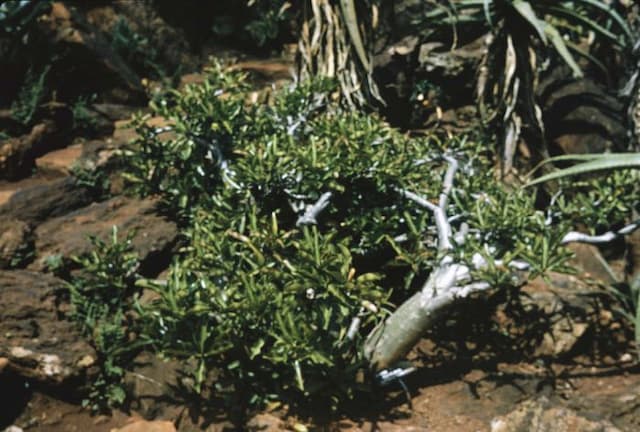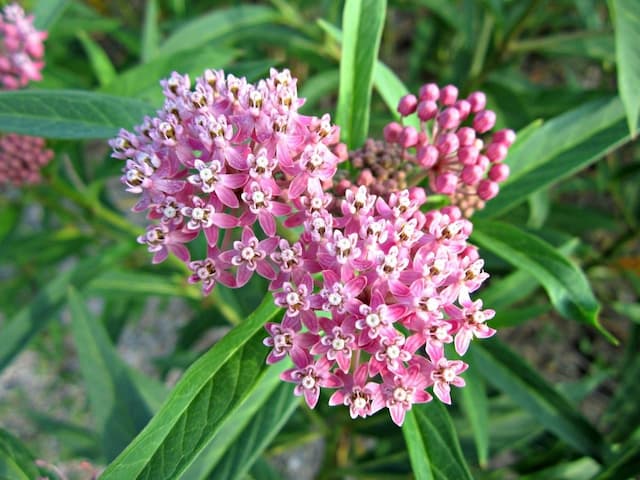White Mandevilla Mandevilla boliviensis

ABOUT
Mandevilla boliviensis, commonly known as White Mandevilla, is a visually striking plant that captures attention with its large, trumpet-shaped flowers that are a pristine shade of white with a subtle yellow throat, creating a stunning contrast against the green foliage. The flowers' elegant form and coloring give it a delicate, yet vibrant appearance. The leaves of the White Mandevilla are glossy, with a deep green hue, and are oblong to elliptical in shape, offering a lush backdrop for the showy blossoms. This plant tends to have a twining growth habit, with stems that can gracefully climb and intertwine with supports, making it an excellent choice for trellises, arbors, or as a flowing cascade in a hanging basket. The overall impression of the White Mandevilla is one of tropical sophistication and charm, which is further enhanced when it is in full bloom with its clusters of alluring white flowers.
About this plant
 Names
NamesFamily
Apocynaceae
Synonyms
White Dipladenia, Bolivian Sunset, Mandevilla Boliviensis
Common names
Mandevilla boliviensis
 Toxicity
ToxicityTo humans
Mandevilla is not widely recognized for severe toxicity to humans, but it can have mild toxic properties. If ingested, parts of the Mandevilla plant may cause gastrointestinal upset, such as nausea, vomiting, or diarrhea. Additionally, the plant's sap may irritate skin and mucous membranes, so it's advisable to handle the plant with care, especially if you have sensitive skin. To avoid the potential for negative effects, keep Mandevilla out of reach of young children who might inadvertently ingest plant material.
To pets
Mandevilla can be toxic to pets if ingested. The plant contains compounds that may irritate the gastrointestinal tract, leading to symptoms such as vomiting, diarrhea, drooling, or abdominal pain. In some cases, the consumption of Mandevilla by pets may result in more severe symptoms, so it is important to keep this plant out of reach of pets. If you suspect your pet has ingested part of a Mandevilla plant, contact your veterinarian for advice and potential treatment.
 Characteristics
CharacteristicsLife cycle
Perennials
Foliage type
Evergreen
Color of leaves
Green
Flower color
White
Height
10 feet (3 meters)
Spread
3 feet (1 meter)
Plant type
Climber
Hardiness zones
10
Native area
South America
Benefits
 General Benefits
General Benefits- Enhances Aesthetics: Mandevilla brings a tropical and exotic feel to any landscape or garden with its showy flowers and attractive foliage.
- Attracts Pollinators: Its bright, trumpet-shaped flowers are known to attract hummingbirds and butterflies, promoting biodiversity.
- Low Maintenance: Mandevilla plants are relatively easy to care for, requiring minimal pruning and occasional watering once established.
- Versatile Planting Options: Can be grown in containers, hanging baskets, or trained along trellises and fences, allowing for a variety of garden designs.
- Durability: Mandevilla is resistant to many pests and diseases, which reduces the need for chemical treatments.
- Long Blooming Period: It offers a long season of blooms from spring until fall, providing continual color and interest in the garden.
- Creates Privacy: When grown on trellises, Mandevilla serves as a lush screen that can create privacy in outdoor spaces.
- Improves Mental Well-being: Like many ornamental plants, the beauty of Mandevilla can contribute to relaxation and stress reduction for gardeners and onlookers.
- Adaptable to Climate: It is suited for warm climates but can also be overwintered indoors in cooler regions, making it adaptable to many environments.
- Easy to Propagate: Mandevilla can be easily propagated from cuttings, making it possible to create more plants and share with others.
 Medical Properties
Medical PropertiesThis plant is not used for medical purposes.
 Air-purifying Qualities
Air-purifying QualitiesThis plant is not specifically known for air purifying qualities.
 Other Uses
Other Uses- Crafting Natural Dyes: The sap and flowers of the Mandevilla can sometimes be used to create natural dyes for fabrics or artisanal crafts, presenting a range of soft hues.
- Education and Research: Mandevilla plants are often used in educational settings to teach principles of botany, plant biology, and horticulture.
- Perfumery: On rare occasions, the fragrant blooms of the Mandevilla may be used in the production of perfumes or scented oils, although this is not a common usage.
- Photography Props: Garden photographers sometimes use the attractive Mandevilla flowers as subjects or backdrops for botanical photography due to their striking appearance.
- Culinary Garnish: Although not widely known for its edibility, some flowers of the Mandevilla may be used as decorative, non-toxic garnishes for culinary dishes in haute cuisine.
- Artistic Inspiration: Artists may take inspiration from the beauty of the Mandevilla flowers, translating their form and color into paintings, drawings, or textile patterns.
- Spiritual and Cultural Symbolism: In certain cultures, the Mandevilla may carry symbolic meaning and can be used during spiritual or religious ceremonies as a symbol of peace or beauty.
- Butterfly Gardening: Mandevilla plants can attract pollinators like butterflies to a garden, thereby enhancing the biodiversity and health of the garden ecosystem.
- Living Fences: Some gardeners use Mandevilla vines to create living fences or privacy screens, as they can grow quite tall and dense when supported properly.
- Floral Arrangements: Mandevilla blooms can be incorporated into floral arrangements for events or as part of home decor, although they may not last as long as some other cut flowers.
Interesting Facts
 Feng Shui
Feng ShuiThe Mandevilla is not used in Feng Shui practice.
 Zodiac Sign Compitability
Zodiac Sign CompitabilityThe Mandevilla is not used in astrology practice.
 Plant Symbolism
Plant Symbolism- Radiant Beauty: The Mandevilla, with its captivating trumpet-shaped flowers, symbolizes radiant beauty and splendor, reflecting its showy and attractive appearance.
- Passion: Often associated with passionate feelings, the bold and vibrant colors of the Mandevilla flowers represent intense love and strong emotions.
- Tropical Escape: Native to tropical regions, the Mandevilla plant signifies escapism and the allure of exotic destinations, highlighting a sense of adventure and relaxation.
- Charm and Grace: The elegant growth habit and glossy foliage of the Mandevilla portray charm and grace, suggesting a delicate yet impactful presence in a garden setting.
 Water
WaterFor Mandevilla, also commonly known as rocktrumpet, the key is to maintain consistently moist soil without making it waterlogged. During the growing season, water your rocktrumpet thoroughly once the top inch of soil feels dry to the touch, which typically means once a week with about 1-2 gallons depending on the size of your plant and environmental conditions. Reduce watering in the cooler months to prevent root rot, providing perhaps half a gallon every two weeks as the plant requires less moisture when it's not actively growing. Always use lukewarm water and try to avoid getting water on the foliage, as this can promote fungal diseases.
 Light
LightRocktrumpet thrives best in bright, indirect sunlight. A spot that provides morning sunlight with partial shade in the intense afternoon sun is ideal. If indoors, a south or east-facing window can work well. Too much direct sunlight can damage leaves, while insufficient light can lead to poor flowering.
 Temperature
TemperatureRocktrumpet prefers to be in temperatures between 60 and 85 degrees Fahrenheit. They can tolerate a minimum temperature down to about 50 degrees Fahrenheit but should be protected from frost. Ensure that rocktrumpet plants are moved indoors or to a warmer spot if temperatures start dropping below this range.
 Pruning
PruningPrune rocktrumpet to maintain shape and encourage bushier growth. The best time for pruning is in the spring, just as new growth begins. It's usually sufficient to prune once a year, but if the plant is vigorous, a second pruning in late summer may be beneficial. Remove any dead or damaged stems to promote healthy growth and reduce disease risk.
 Cleaning
CleaningAs needed
 Soil
SoilWhite Mandevilla thrives in well-draining, rich soil with a pH between 5.5 and 6.5. A mix of peat, pine bark, and perlite or sand works well to promote healthy growth.
 Repotting
RepottingWhite Mandevilla should be repotted every 2-3 years or when it becomes root-bound. Springtime is ideal for repotting to allow the plant to recover during the growing season.
 Humidity & Misting
Humidity & MistingWhite Mandevilla prefers high humidity, around 50-60%. If indoor air is dry, using a humidifier or pebble tray can help meet its humidity needs.
 Suitable locations
Suitable locationsIndoor
Place White Mandevilla near a bright window and ensure high humidity.
Outdoor
Plant White Mandevilla in partial shade and protect from strong winds.
Hardiness zone
10-11 USDA
 Life cycle
Life cycleThe White Mandevilla begins its life cycle when its seeds germinate in moist, well-draining soil and warm conditions. Seedlings emerge and develop into juvenile plants with a robust root system and foliage that prepares them for photosynthesis and growth. As the plant matures, it enters a vigorous vegetative stage, characterized by the development of sprawling vines and lush, green leaves, in ideal conditions of full to partial sun and regular watering. Once mature, the White Mandevilla produces trumpet-shaped white flowers that are particularly attractive to pollinators, marking the plant's reproductive phase, which occurs periodically throughout the warm months. After pollination, seed capsules form that will eventually dry and release seeds, propagating the next generation. During the winter or in cooler climates, the plant experiences a dormant period where growth slows considerably until favorable conditions return.
 Propogation
PropogationPropogation time
Spring-Early Summer
Propogation: The most popular method of propagating a Mandevilla, also known as Mandevilla boliviensis, is through stem cuttings. This is typically done in spring or early summer when the plant is actively growing, ensuring the cuttings have the best chance to root. To propagate, a gardener should select a healthy, non-flowering stem and cut it to about 4-6 inches (about 10-15 centimeters) in length, just below a leaf node. The leaves on the lower half of the stem are then removed, and the cut end is dipped in rooting hormone to stimulate root growth. The prepared cutting is placed in a well-draining potting mix, ensuring that at least one node is buried where roots can develop. The pot is then kept moist, but not waterlogged, and placed in indirect light until roots have established, which can generally take a few weeks. COVER LETTER









